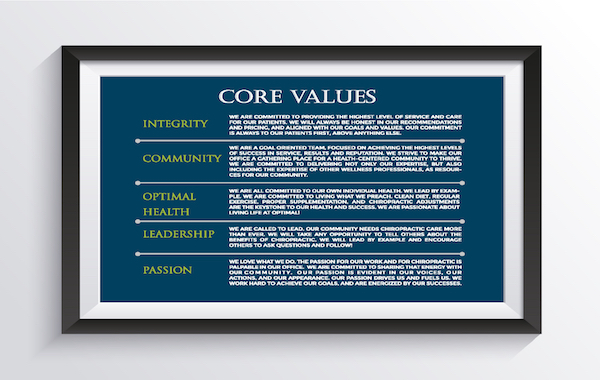Picture the scene. Marks & Spencer. 1988. A warehouse up north. 50 students have just been hired over Christmas to cope with the additional workload. On their first day, they’re summoned to a briefing by the Foreman. He tells them that they’ll be fired if they work too hard. Why? Because they might show up the permanent staff who work there all year round. I kid you not. When I heard about this as a Trainee Assistant Manager, I was appalled. It just didn’t feel right. This was my first experience of the power of culture.
And yet, at the same store, there were some excellent leaders. The General Manager fired a load of staff because they simply didn’t come to work one Saturday. He was apoplectic that they didn’t seem to care enough. I was struck by the lack of unanimity. There was no collective feeling of excellence. Something was broken in the culture.
Throughout my career, I’ve become convinced that culture is at the root of business growth. It was the biggest factor that enabled me to scale two tech companies (Rackspace and Peer 1) from zero revenue to £30 million in just five years (and during two recessions). Recruitment, productivity, engagement, reputation, profitability – they are all heavily impacted by culture.
It amazes me how few businesses have really got a handle on this though. So, I’m busting some of the more common myths in this blog, to really get to the heart of culture and why it’s important.
Myth 1 – Culture is fixed. It can’t be changed
Maybe you think culture is something you can’t manage? It evolves over time and becomes fixed – sometimes it’s good, sometimes it’s bad. But you can’t do anything about it.
Well, you’re wrong! There’s no doubt that it’s easier to build a culture up from the very beginning. We did this in the early days at Rackspace. Our culture evolved when an employee, Anne, came to me to complain about a colleague, Ed. She said we shouldn’t have hired him. Ed was lazy and didn’t value what was important in the business. I asked her to help me define what that was – the Rackspace behaviours that united us and formed our culture. We came up with a list of 15 and started to use them in reward exercises such as Employee of the Quarter. This was the genesis of our core values.
It’s much, much harder to change an established culture. But it is possible – it just takes blood, sweat and tears! We did this when I took over as MD of IT Lab. The culture needed to change radically for the business to survive. It was just after the financial crash and we were haemorrhaging cash. I put in place a whole new structure of working based around regular rhythms, transparency, celebration and rewards.
The aim was to get really clear about expectations and create a self-sustaining flywheel building towards a positive new culture. Evidence that it was working came in the appearance of new rituals that I’d had little to do with. If they reinforced the culture, they were encouraged. After eighteen months, the company began to thrive and this was down to the new culture we’d created.
Myth 2 – Culture is about bean bags and free beer

People often get fixated on the office environment and free stuff when they think about culture. Bean bags, pool tables, free beer – they certainly help but they are by no means the definition of a good culture. You can have the best environment in the world and still have miserable staff and unhealthy culture.
For me, it’s more about the people that you hire and whether they fit with your business. Going back to M&S – some of the staff were extremely committed. We had particular success with our early morning shelf-filling shift. We hit on the idea of hiring Jehovah’s Witnesses – they were smart, professional and only wanted to work until 9am. This was a huge success – we’d found people for whom the job was perfect.
There I was – a young Assistant Manager in my early twenties with a team of 50 part-time and full-time middle-aged women. I couldn’t tell them what to do. Instead, I earned their respect by being open and honest. In stark contrast to organisational norms, I didn’t merchandise the food hall but instead allocated responsibility to individuals to merchandise and shelf fill their own sections. As Dan Pink would confirm later in his book ‘Drive’, team members are motivated by autonomy and mastery.
Myth 3 – Culture changes according to your manager and team
Some people say there’s no such thing as an overall business culture. It changes according to the team that you’re in and who your manager is. I have a bit more sympathy for this view. There’s no doubt that the culture of an individual team can be just as influential as the overall culture of a firm.
This is because individual team culture has such a profound effect on employee engagement. In fact, Gallup has found that 80% of the employee engagement score on their Q12 survey is driven by the manager and team. You could argue that company culture is all of the individual team cultures added together. So, it’s important to influence this holistically by identifying and encouraging unifying behaviours that unite everyone.
It’s also possible to find geographical variations in culture. When I worked for Peer 1, we had 22 locations across Canada, the US, England and France. Each office had a slightly different take on culture. We all had ‘beer o’clock’ but it was observed differently according to where you were based and what the rules were. In Vancouver, they came up with a ‘Peer-tini’ cocktail. In France, it was wine. The UK? Beer (no surprise there!) Some even drank fruit smoothies. However, the ritual was consistent and everyone looked forward to relaxing together at the end of a busy week.
Myth 4 – Culture is all about the values on the wall

Too often, companies pay lip service to core values. They go through an expensive exercise ending up with vague, meaningless words that mean nothing to anyone. They’re slapped up on the wall and added to company literature. But they’re not lived and breathed by the staff.
Properly executed and embedded, core values are the definition of your company’s culture. They’re a shorthand way of capturing behaviours that you see as important in your business. They only work if you can hire, promote and fire within them. If you can’t do this, chances are they’re not right and you need to revisit them.
You need to get to the root of shared beliefs in your organisation. Here’s a great illustration. On my first day at Pipex, the Customer Service Director took me around the call centre. As I walked in, I noticed three copies of the phone book lying on the floor, covered in dust. I turned to him and said, ‘Let me show you around’. He looked puzzled. What did I mean? I pointed to the dirty directories and said, ‘How long have those been there. Months? Years? For all that time, you’ve walked past them and ignored them, so your staff have done the same.’ It was clear that nobody really cared – there was no sense of collective pride.
I can go into the Reception of any business and know, instantly, whether it wants to be great. Whether it’s really trying. The same goes for a company’s approach to meetings. If they’re badly run and disorganised, this will be representative of the whole business. How you manage your time and other people’s is a fundamental behaviour.
All these things stack up and build into a positive or negative culture. You can’t just put the values on the wall and think you’ve changed the culture.
What exactly is culture?
My conclusion is culture is all about shared behaviours and beliefs. A favourite phrase of mine is ‘Culture is what people do when no one is watching’ – that really resonates with me. If you want to get to grips with your company’s culture, you need to get to the root of the deeply held beliefs that exist in your business.
You don’t need many people with fixed ideas before behaviours start to stick. And it can be hard to challenge accepted orthodoxies once they become established. You see this in attitudes to customer service. When I think back to the TelCo organisations that were our competitors at Peer 1 and Rackspace, the leadership teams seemed to believe that customer service was a cost and not a profit centre. So, they had a denial of service mindset. They hired other people with the same belief and put them to work. This made it easy for us to stand out with our purpose of ‘fanatical support’ – the driving force of our exponential growth.
Beliefs vary according to geographical upbringing. There’s a great book written by the world’s greatest culture guru Fons Trompenaars that illustrates this. ‘Did the Pedestrian Die?’ describes the different cultures in various European countries. Here’s the premise. A friend is driving you home after a night out where you’ve had a few drinks. There’s a thud but he doesn’t stop. His lawyer rings to ask if you’d be prepared to go to court to say nothing happened and you didn’t hear the thud. What would be your answer? Most people in the UK believe drink driving is wrong, so they said no. However, the French asked, ‘Did the pedestrian die?’ (hence the book title). There you have it – deep, underlying cultural beliefs. They shape all human relationships and our perceptions of truth.
Why is culture important?
Culture is the difference between excellence and mediocrity. It’s the engine oil of a business, greasing the cogs of future growth and prosperity. You can’t underestimate its impact. It will influence recruitment and retention of the right people, engagement and productivity, profitability and customer service – every aspect of future success.
At my first workplace, M&S, the culture wasn’t uniform. The company had some talented people who worked hard, and others who just didn’t care. You saw this in the results. Stores that created great cultures performed 5% better than identical stores in other locations. The stock was the same, the fixtures the same, the prices the same. The only lever the General Managers could pull was people. The successful stores set high expectations and repeatedly called out the staff who were doing the right thing.
By drilling deeply into the collective beliefs, thoughts and feelings of your business, you can uncover a meaningful purpose and values. They need to be written in a way that’s emotional – showing that your company stands for something. Then you will attract more of the people who believe what you believe. And you can use your values to drive social currency, saying this is how we work and this is what we expect. If it isn’t the right place for you, you need to leave.
After this, you can look at whether your culture supports excellence. Do you get rid of poor performers, for example? This is a big one. I don’t believe that you can transform Blackpool beach donkeys into Grand National winners by adding training, development and motivation. Just impossible! If you want a high performing business that grows by 20% over three years, you need ‘A-Players’ (these being the top 5 to 10% of available talent for a given job, salary and location). And you need a culture that attracts them.
Culture matters. It’s an evolving set of beliefs, behaviours and attitudes that define your business. These beliefs can make or break your company, having a huge impact on strategic direction and growth.
Written by business coach and leadership coaching expert Dominic Monkhouse. Contact him to schedule a call here. You can order your free copy of his book, Mind Your F**king Business here.

